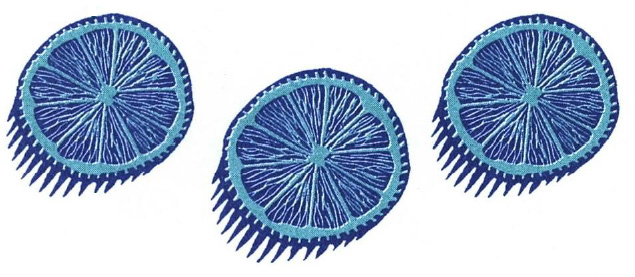The Sugar Mill Caribbean Cookbook (27 page)
Read The Sugar Mill Caribbean Cookbook Online
Authors: Jinx Morgan

| 18 to 24 | oysters, shucked |
| 1 | cup flour |
| 2 | eggs |
| 1 | cup dry bread crumbs |
| 1 | teaspoon Cajun Seasoning (see [>] ) |
| 2 to 4 | tablespoons butter |
Heat the oil in a heavy (preferably cast-iron) skillet over high heat until the oil begins to smoke. Add the ¾ cup flour, and continue to heat, stirring, until a dark red-brown roux is formed, about 3 to 5 minutes. Remove the skillet from the heat, and add the chopped celery, onion, and bell peppers, and the 1 tablespoon Cajun Seasoning. Stir the mixture until it is cool.
Add enough fish stock or clam broth to the oyster liquor to make 2½ cups. In a pot, bring 2 cups of the liquid to a boil, and gradually add the roux-vegetable mixture. Heat, stirring, until the roux is dissolved.
In a skillet, sauté the green onions ' in the butter, and add the diced shrimp. When the shrimp is pink, firm, and cooked through, combine the shrimp and green onions with the
etouffée
and adjust the consistency of the
etouffée
, if you like, with the remaining stock. Keep the
etouffée
hot.
To prepare the oysters, dip them into the flour, then into the beaten egg, and finally into the bread crumbs seasoned with the 1 teaspoon Cajun Seasoning. In a skillet, sauté the oystersin the butter until they are crisp and golden brown, about 2 minutes on each side.
Serve the
etouffée
over white rice surrounded by the oysters.
Â
Makes 6 servings
There are many views about the appropriate way to dispatch lobsters. Some favor a quick, clean kill using a knife. Others plunge the lobsters into boiling water. Soft-hearted souls put them into room-temperature water and bring it slowly to a boil, and those with the most tender sensibilities add a glug or two of vodka to the water to be sure the lobster passes into lobster heaven in tipsy bliss.
Sofrito,
the basis of the sauce for this dish, was brought centuries ago from Spain to the Caribbean, where today its savory influence can be tasted on many islands. Make it ahead, if you like; it will keep in a covered container in the refrigerator for up to two weeks.
Â
| 1½ | cups finely chopped salt pork |
| 1 | teaspoon annatto oil (see [>] ) |
| 1½ | cups minced onions |
| 2 | teaspoons minced garlic |
| ½ | cup chopped green bell peppers |
| 3 | ounces lean boneless ham, cut into ½-inch cubes |
| ½ | cup peeled, seeded, and chopped tomatoes |
| 1 | teaspoon dried oregano |
| 2 | tablespoons minced cilantro or parsley |
| Â | Â |
| 2 | 1½- to 2-pound live lobsters, or an equivalent amount of lobster tails |
| 3 | tablespoons annatto oil (see [>] ) |
| 1 | cup dry white wine |
| Â | Minced cilantro or parsley |
| Â | Lemon wedges |
Sauté the salt pork in a heavy skillet over moderate heat, stirring often, until the salt pork is crisp and brown. Pour off all but 2 tablespoons fat. Add the annatto oil to the pan. Add the onions, garlic, and peppers, and sauté the vegetables for 5 to 10 minutes, until they are soft but not brown.
Add the ham, and stir until the mixture is well covered with oil. Stir in the chopped tomatoes, oregano, and cilantro or parsley. Reduce the heat to low, cover the pan tightly, and simmer for 30 minutes, stirring the mixture occasionally to prevent the vegetables from sticking to the bottom of the skillet. Let the
sofrito
cool, and reserve it.
Kill each lobster by plunging a knife into its back between the body and head, or by dropping it into rapidly boiling water and letting it cook for 1 minute. (Believe us, you'll feel worse about this step than the lobster does.)
Remove and discard the gelatinous sac in each head, and the long intestinal vein attached to the sac. Wash the lobsters well, and, with a sharp, heavy knife or heavy shears, cut the tail into medallions. Cut the body in half, clean it, and save the tomalley (liver) and any coral (roe) for the sauce. If you are using lobsters with claws, remove them.
Cook the head in rapidly boiling water for about 4 to 5 minutes, or until the shell turns red. Let the head cool, and reserve it for garnish.
Heat the annatto oil over high heat in a heavy skillet or wok. Add the lobster pieces, and fry them for 3 to 4 minutes, turning constantly, until the shells turn pink. Transfer them to a platter.
Pour all but a thin layer of oil from the skillet, add the wine, and bring it to a boil over high heat. Stir in the
sofrito,
and return to the skillet the lobsters and any liquid that has accumulated around them. Cover the skillet tightly, and simmer the lobster for 8 to 10 minutes, basting from time to time with a large spoon.
Arrange the lobster pieces on a large platter, over rice or on their own, and garnish with the lobster head, cilantro or parsley, and lemon wedges. Serve the lobster hot.
Â
Makes 2 to 4 servings

A vegetable of many names, the christophene is known as mirliton in Louisiana and chayote in Latin America. It's a green, pear-shaped vegetable from a West Indian vine of the cucumber family. The seed is edible and delicious cut up in salads. If you can't get christophenes, you can substitute Jerusalem artichokes or fresh water chestnuts in this recipe.
Â
| ½ | cup minced shallots |
| 2½ | cups dry white wine |
| ¾ | cup brandy |
| About 5 teaspoons curry powder, to taste | |
| 1 | cup coconut cream (see [>] ) |
| 2 | cups heavy cream |
| Salt, pepper, and cayenne to taste | |
| 3 | cups cooked lobster meat, cut into chunks |
| ¾ | pound asparagus, trimmed, blanched, and cut into bite-size pieces |
| ¾ | pound christophene (chayote), peeled, cut into bite-size pieces, and cooked until just tender |
Combine the shallots, wine, brandy, and curry powder in a saucepan, and reduce the mixture over medium heat to about ¾ cup. Strain the mixture, and return the liquid to the pan. Add the coconut cream and heavy cream. Reduce this mixture to 2½ cups over medium heat.
Season the sauce with salt, pepper, and cayenne. Add the lobster, asparagus, and christophene. Heat the curry, and serve it in lobster shells or on a bed of white rice.
Â
Makes 6 servings
Trade Winds Chicken with Pineapple Salsa
[>]
Island Chicken
[>]
Chicken Breasts Ensalada
[>]
Carambola-Glazed Barbecued Chicken
[>]
Grilled Chicken Breasts with Papaya-Cilantro Vinaigrette
[>]
Chicken Breasts with Spinach Mousse and Pinot Noir Sauce
[>]
Grilled Chicken Breasts with Gazpacho Salsa
[>]
Chicken and Papaya Stir-Fry
[>]
Chicharrone de Pollo
[>]
Roast Chicken with Poached Garlic
[>]
Chicken Curry
[>]
Garden Roasted Chicken
[>]
Rum-Glazed Roast Turkey Breast with Plantain and Mango Stuffing
[>]
Cornish Game Hens with Mango-Curry Butter
[>]
Tropical Citrus Game Hens
[>]
Honey-Lime Duck
[>]
Mahogany-Glazed Duck Breast with Sesame-Peanut Noodles
[>]
Roasted Ginger Duck with Pork-and-Almond Stuffing
[>]
Grilled Quail with Mango-Papaya Sauce
[>]

We've adapted this from a super salsa recipe given to us by one of our guests, Jaqueline Higuera McMahan, who has written three sizzling cookbooks,
California Rancho Cooking, Salsa,
and
The Red and Green Chile Book.
(All are published by The Olive Press, P.O. Box 194, Lake Hughes, California 93532.)
Â
| 3 | garlic cloves, minced |
| 1 | teaspoon salt |
| ¼ | cup olive oil |
| 1 | tablespoon malt vinegar |
| 1 | teaspoon garlic powder |
| 1 | tablespoon paprika |
| 2 | tablespoons lime juice |
| 1 | packet Sazón seasoning (see [>] ) or ½ teaspoon turmeric or 1 pinch saffron |
| Â | Vegetable oil, for frying |
| Â | Â |
| 4 | chicken breast halves |
| 2 | cups diced fresh pineapple |
| ½ | peeled and diced christophene (chayote) |
| ½ | cup minced red onion |
| ½ | cup diced red bell pepper |
| 1 | jalapeño pepper, seeded and diced |
| 2 | teaspoons minced gingerroot |
| 1 | tablespoon raspberry vinegar |
| Â | Salt to taste |
| Cilantro sprigs |
Purée all the marinade ingredients in a blender. Place the chicken in a baking pan, pour the marinade over, and marinate the chicken in the refrigerator overnight.
To make the pineapple salsa, combine all the ingredients, and taste. You might like to add some chopped fresh cilantro or more peppers.
Preheat the oven to 400°. Bake the marinated chicken for 30 to 40 minutes, until its juices run clear.
Remove the pan from the oven, and let the chicken cook in its marinade.
Just before serving time, drain the chicken well, and fry it for 3 minutes in â
inch of oil.
Serve each chicken piece with a dollop of pineapple salsa (on the top or side) and a sprig of fresh cilantro.
Â
Makes 4 servings
